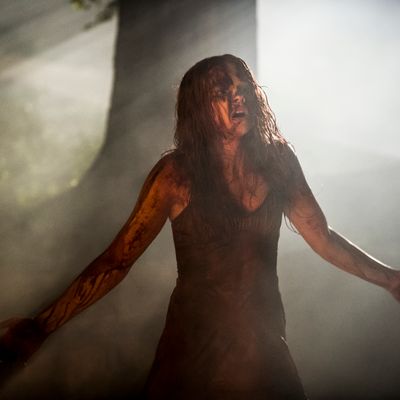
Apart from an early scene with a cartoonish high school principal, Brian De Palma’s 1976 Carrie is well-nigh perfect — a lyric, Expressionistic horror classic with the greatest female performance (by Sissy Spacek) in genre history and a supporting turn (by Piper Laurie) that’s not too far behind it. (I could go on and on about Amy Irving, Nancy Allen, darling P.J. Soles, John Travolta, etc.) Above all, it’s a movie that takes no prisoners. The well-meaning die as gruesomely as the malevolent. The one character left alive is probably too damaged to recover. As much of a hot dog as De Palma is (few directors are as gleefully virtuosic), he rarely takes off into a solipsistic sphere: Every trick both delights him and heightens his characters’ emotions.
I won’t pretend I wasn’t incensed when I heard about a Carrie remake in the works, but I went in with an open mind and heart. The director, Kimberly Peirce, could in theory provide the one thing De Palma couldn’t — a female gaze — and the ideas she explored in Boys Don’t Cry about gender and female self-image made it likely she’d at least bring something new to the party. Based on the finished movie, though, I’m wondering if she had any say in what finally hit the screen.
The new Carrie isn’t atrocious — just flat and uninspired and compromised by the kind of mindless teen-movie “humanism” that De Palma so punkishly spat on. (It’s atrocious by comparison.) A TV hack from Glee came in to cross the ts and dot the is in Lawrence D. Cohen’s original screenplay (based on Stephen King’s novel). He makes Carrie’s religious wackadoodle mom (Julianne Moore) a self-cutter, and he has the girls who jeer and throw tampons at Carrie in the girls’ locker room take video of her cowering, sobbing form and post it online. (But — implausibly — there’s no fallout from this.) The rest of his work consists of having Carrie (Chloë Grace Moretz) distinguish between the mean girls who’ve taunted her and those who’ve tried to help her. She lets the former go and serves up protracted vigilante justice (probably more satisfying to bloodthirsty modern audiences) to the bad-‘uns.
What’s lost is the primal, inexplicable, truly demonic power. As the stunted Carrie, Moretz has a heart-shaped face — she’s all cheekbones and pillowy lips and is more conventionally attractive than the pale, freckled, otherworldly Spacek. A higher percentage of the target demographic will relate to her better. To convey Carrie’s alienation, Moretz hunches her shoulders and tilts her head down so that her hair hangs in her face. She’s like Ally Sheedy from The Breakfast Club in desperate need of a scholarship to Professor Xavier’s school for mutants. The most haunting thing about Carrie’s powers in the original — that they erupt from her as a consequence of trauma plus adolescent hormones, that they’re more unconscious than not — has been domesticated. Now she plays around with controlling her telekinesis, orchestrating objects and conducting the climactic destruction number as if it’s a Mahler symphony. Her pleas to her mother have nowhere near enough urgency: They don’t come from the depths of a soul in torment but a conventional sad adolescent in need of a bestie and a hairdresser. Moore, meanwhile, makes Margaret White a more realistic — and tedious — sniveler. The character’s riotous punch line — that she has her first orgasm as she’s crucified — has no place in so dull a conception.
I imagine kids will line up for Carrie, though — it panders to their sense of entitlement, and it ends with a tidy anti-bullying message. (There’s no female pubic hair on display, either, as in the original, which means no cluck-clucks from the bluestockings.) Maybe the Glee generation will even prefer this version. But no one who loves De Palma’s landmark will be able to endure it. And Kimberly Peirce should hang her head in shame.


